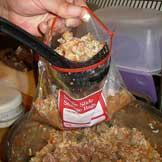
Are you still seeing fleas after using a topical flea prevention treatment? What should you do now?
This is a question asked by frustrated pet parents with itchy pets every day.
You might be wondering if you applied it incorrectly, and if so, whether you should reapply. Or maybe the flea treatment stopped working for your pet.
Here’s why you might still be seeing fleas and what you should do about it.
Is It Safe to Reapply a Flea Treatment Early?
If you are finding fleas on your pet even after applying your pet’s topical flea treatment, you might consider reapplying it early. However, this solution is not always recommended and may lead to an overdose in some rare cases.
There are so many different products available on the market, so it is difficult to speak to all of them in broad strokes. To be safe, you should always follow the instructions on your specific topical flea medication package.
Flea preventions typically use one or two active ingredients to do the job of preventing fleas. Each brand will use different active ingredients, and these ingredients will work in different ways to prevent fleas.
An overdose for most flea preventions could result in the following:
-
Profuse drooling
-
Vomiting
-
Tremoring
-
Hyperexcitability
-
Agitation
-
Seizures
-
Weakness
-
Difficulty breathing
Why Isn’t My Flea Treatment Working?
You’ve been diligently applying topical flea prevention to your pets, but you are still seeing them scratch, and you might even be seeing fleas. Here are four common reasons why this might be happening.
Incorrect Application of Flea Treatment
Incorrectly applying topical flea prevention is the most common cause for its failure to work. Flea prevention is expensive, and you don’t want to waste a dose.
Topical medication should be applied directly to the skin, not the hair. You must part the hair so that you can apply it to the skin at the base of the neck. Read the instructions on the package; most direct you to apply it all in one spot on the neck, while a few will have you apply it to several spots along the back that the pet cannot reach (for larger dogs).
Be sure to completely empty the tube, as the liquid is measured for your pet’s weight range and the entire dose is required to be effective.
How to Apply Each Brand of Topical Flea Treatment
Applying it correctly can be very tricky because each type has a different way to open the tube and ensure that it dispenses properly. Here are the three major brands and how to apply them.
Bravecto
-
Hold the tube upright and turn the cap one full turn.
-
Make sure the seal is broken but DO NOT remove the cap.
-
Cats: Part the hair at the base of the neck and apply the entire tube to the skin. You can apply to a second spot directly behind the first if there is overflow.
Dogs: Part the hair at the base of the neck and apply to the skin; do this in one or more spots depending on the size of your dog. For larger dogs, choose two or three spots along the spine to continue the application.
Revolution/Revolution Plus:
-
Hold the tube upright and press the cap firmly until you hear a click.
-
Remove the cap and make sure that seal has been broken.
-
Part the hair at the base of the neck and apply the entire tube to the skin.
-
Keep the tube squeezed so the liquid isn’t sucked back into the tube.
-
Make sure the tube is empty.
Advantage Multi
-
Hold the tube upright and remove the cap.
-
Flip the cap upside down and push the tip into the top of the tube.
-
Twist the cap to break the seal, and then remove the cap.
-
Cats and Dogs < 20 lbs.: Part the hair at the base of the neck and apply the entire tube to the skin.
Dogs > 20 lbs.: Part the hair at the base of the neck and apply to the skin; do this in one to three more spots from the neck to the upper back depending on the size of your dog.
-
Keep the tube squeezed so the liquid isn’t sucked back into the tube.
-
Make sure the tube is empty.
Your Flea Medication Has Become Ineffective
While you can reapply flea treatment early in some cases, you should talk to your veterinarian to find the best and most effective flea treatment for your pet.
Your vet will know which products are working well in your region, as some that may have been effective at one time may no longer be killing fleas the way they used to. They may also have personal favorites or recommendations based on your pet’s particular needs.
Your Home Hasn’t Been Treated for Fleas
In conjunction with topical flea treatments, you need to treat your home to provide the best defense against fleas.
Most flea preventions do not repel fleas. Flea preventions kill fleas either by direct contact with the fleas or from the fleas feeding on your pet.
New fleas from the environment can—and will—jump onto your pet to feed. So, it’s extremely important to treat your pet’s environment, too. And it’s not just adult fleas you need to watch out for, because they only make up less than 5 percent of the flea population.
You should be treating your home for adults plus the other 95 percent—flea eggs, flea larvae and flea pupae.
Flea eggs and larvae can live in the environment for days or weeks. It is best to regularly vacuum all the locations of your home where your pet spends time, wash all bedding in hot water, and keep your pets on flea prevention.
Not All of Your Pets Are on Flea Treatment
Don’t forget to treat all of the dogs and cats in your house, not just the itchy ones.
Some pets will scratch more than others, but if one pet in the house has fleas, they all have fleas. All of your pets will need to stay on flea medication to prevent reinfestation.
Just because you don’t see a flea doesn’t mean they don’t have fleas or don’t need to be on flea treatment.
Featured Image: iStock.com/Liliboas










